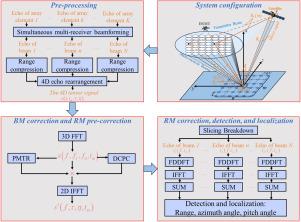无源双基地阵列雷达高速运动目标同步多波束空时多普勒相干积分检测
IF 3.6
2区 工程技术
Q2 ENGINEERING, ELECTRICAL & ELECTRONIC
引用次数: 0
摘要
高速运动目标对无源双基地阵雷达(PBAR)提出了挑战。当hsmt偏离发射-接收光束的辐照区域时,PBAR无法在较长时间内有效接收回波能量,无法平衡相干积累时间和方位精度。一个解决方案是使用卫星的宽波束和多个相邻的来自地面静音阵列雷达的窄接收波束。然而,在长时间的积累过程中,hsmt的径向和切向速度引起距离偏移(RM)、俯仰波束偏移(PBM)、方位波束偏移(ABM)和多普勒频率偏移(DFM)。这些散射HSMT回波能量,降低了长时间相干积分(LTCI)性能。提出了一种同步多波束时空多普勒(STD)算法。首先,采用相位校正和对消相结合的联合波束偏移校正机制,将多波束能量聚焦在HSMT终端时刻的波束单元上,然后利用频域Dechirp Fourier变换(FDDFT)对RM和DFM进行处理,将回波多普勒频率和调制频率调至同一域完成相干积分,最后通过多波束联合质心角测量实现对HSMT的检测和定位。仿真结果验证了该算法在高速目标检测和相干积分方面的优越性。本文章由计算机程序翻译,如有差异,请以英文原文为准。

Simultaneous multi-beam space-time-Doppler coherent integration for high-speed moving target detection in passive bistatic array radar
High-speed moving targets (HSMTs) pose challenges for passive bistatic array radar (PBAR). When HSMTs deviate from the transmit-receive beam’s irradiation region, PBAR cannot effectively receive echo energy over an extended priod, failing to balance coherent accumulation time and goniometric accuracy. A solution is to use a satellite’s wide beam and multiple adjacent narrow receiving beams from a ground-based silent array radar. However, during long-time accumulation, HSMTs’ radial and tangential velocities cause range migration (RM), pitch beam migration (PBM), azimuth beam migration (ABM), and Doppler frequency migration (DFM). These scatter HSMT echo energy, degrading Long-Time Coherent Integration (LTCI) performance. This paper proposes a simultaneous multi-beam space-time-Doppler (STD) algorithm. First, it employs a joint beam migration correction mechanism combining phase correction and cancellation to focus multi-beam energy on the beam unit at the HSMT’s terminal moment, then utilizes the Frequency Domain Dechirp Fourier Transform (FDDFT) to handle RM and DFM, and tunes the echo Doppler and modulation frequencies to the same domain to complete coherent integration, and finally achieves detection and localization of HSMTs via the multi-beam joint centroid angle measurement. Simulations verify the superiority of the proposed STD algorithm in high-speed target detection and coherent integration.
求助全文
通过发布文献求助,成功后即可免费获取论文全文。
去求助
来源期刊

Signal Processing
工程技术-工程:电子与电气
CiteScore
9.20
自引率
9.10%
发文量
309
审稿时长
41 days
期刊介绍:
Signal Processing incorporates all aspects of the theory and practice of signal processing. It features original research work, tutorial and review articles, and accounts of practical developments. It is intended for a rapid dissemination of knowledge and experience to engineers and scientists working in the research, development or practical application of signal processing.
Subject areas covered by the journal include: Signal Theory; Stochastic Processes; Detection and Estimation; Spectral Analysis; Filtering; Signal Processing Systems; Software Developments; Image Processing; Pattern Recognition; Optical Signal Processing; Digital Signal Processing; Multi-dimensional Signal Processing; Communication Signal Processing; Biomedical Signal Processing; Geophysical and Astrophysical Signal Processing; Earth Resources Signal Processing; Acoustic and Vibration Signal Processing; Data Processing; Remote Sensing; Signal Processing Technology; Radar Signal Processing; Sonar Signal Processing; Industrial Applications; New Applications.
 求助内容:
求助内容: 应助结果提醒方式:
应助结果提醒方式:


